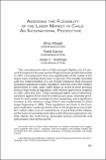Artículo
Assessing the flexibility of the labor market in Chile: An international perspective
Date
2005Abstract
The unemployment rate in Chile averaged slightly over 6.5 percent throughout a ten-year period of high economic growth that ended in 1997. Unemployment then rose significantly at the outset of the Asian crisis, reaching levels near 11 percent. This broadly coincided with the implementation of a set of legal initiatives that increased protection standards in labor regulation. After the end of the military government in 1990, labor codes began to revert to their previous trend of high levels of regulation, with reforms approved in congress in 1990, 1993 and 2001. These introduced higher costs of dismissal, sanctions against firms that fire without just cause, extended provisions for and broader coverage of union bargaining, and a significant increase in the minimum wage (which was implemented in three stages beginning in 1998). These regulations are closer to the European-style labor market protection than to the Anglo-American tradition, which relies more on market forces. A quick look at the relative performance of unemployment rates under these two approaches can help clarify the controversy generated among economists and policymakers during this period.
Collections
View/


